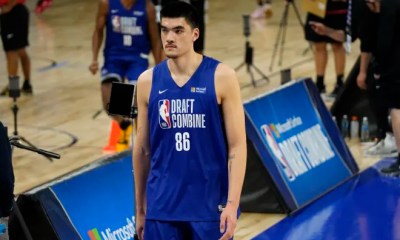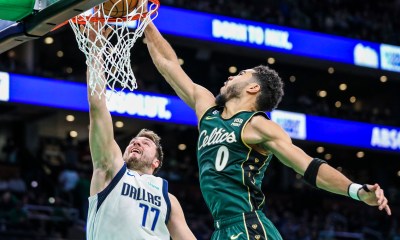
The three-pointer has undeniably transformed the landscape of basketball in several profound ways. Originally conceived as the “home run” of basketball by its founders, the three-pointer has not only become a potent scoring tool but has also reshaped the dynamics of the game. Its introduction has created additional space in the offense, providing driving opportunities for players and leveling the playing field for smaller, more skillful individuals. Beyond its scoring impact, the three-pointer has proven to be a strategic catalyst, altering team dynamics and player roles in the evolving landscape of modern basketball.
Origins
The three-pointer made its initial appearance in college basketball during a test in 1945, featuring a 21-foot line for a single game. However, it did not transition into a permanent rule at that time. The first professional league to adopt the three-point line was the ABL (American Basketball League) in 1961. The ABL aimed to inject excitement into the game and distinguish itself from the larger NBA, envisioning the three-pointer as basketball’s equivalent of the home run. Unfortunately, the league folded after only a year and a half, rendering the three-pointer more of a gimmick in its early years and called a mockery by the NBA.
This concept resurfaced when another startup league, which lasted only one season, incorporated the three-pointer. The ABA (American Basketball Association) embraced the three-point line in its inaugural season in 1967-68. The ABA played a pivotal role in popularizing the three-point line, shaping it into the integral element of the game that we recognize today, alongside its influence on the prominence of the slam dunk.
Selvage & Vaughn
Les Selvage
In the inaugural season of the ABA, Selvage showcased an early prowess for the three-pointer. Demonstrating his sharpshooting skills, he successfully made 147 three-pointers in 78 games, averaging 1.9 makes per game, with an accuracy of .319%. While this may seem modest by contemporary standards, it holds historical significance. When the NBA eventually introduced the three-point line twelve years later, the league leader made 90, and the second-place shooter made 73.
Selvage’s introduction of the three-pointer was remarkable, especially given the era. Having started his collegiate basketball journey at Kirksville State Teachers College and later transitioning to a career at Douglas Aircraft in California, Selvage’s commitment to basketball persisted. Even while engaging in Amateur Athletic Union (AAU) competitions on the side, Selvage caught the attention of the ABA and was signed.
During that pioneering ABA season, Selvage’s three-point attempts were particularly noteworthy. He took more threes than any other ABA team except the Pittsburgh Pipers. In one remarkable game, he attempted 26 three-pointers, making 10—an achievement that, even by today’s standards, stands out. To put it in perspective, Klay Thompson’s NBA record of 24 attempts underscores the impressive volume of three-point attempts Selvage achieved in an era when the NBA saw significantly fewer three-point shots in the 1980s.
Despite pioneering the three point shot Selvage would be waived the following year and play only 4 more games before he was out of the league for good 2 seasons later.
Chico Vaughn
Vaughn had been an NBA player prior to joining the ABA and he was also as prolific as Selvage making 1.9 per game, although he only played in 74 games which is why he came up short of 147 made. He did however shoot them at a better percentage, making .334%. Considering no one had shot three’s to this point and it was a novel concept, these are impressive volumes and percentages. The best percentage of the high volume that season was Darel Carrier who shot 84-235 (.357%) and the highest in the league total was Steve Jones who made 23-54 (.426%)
The First 3 Point Hall of Famer
Louie Dampier, destined for the Basketball Hall of Fame, commenced his professional journey in the ABA after playing college basketball at Kentucky. In the inaugural season, he struggled from beyond the arc, shooting 38-142 at a rate of .268%. However, Dampier orchestrated a remarkable comeback in his second ABA season, setting a new standard for the league by making 199 three-pointers at an impressive .361%, averaging 2.6 per game. This feat was repeated in his third season, where he maintained a nearly identical performance, sinking 198 three-pointers at the same .361% accuracy over 82 games, averaging 2.4 per game.
To contextualize Dampier’s achievements, it’s noteworthy that it wasn’t until the 1994-95 NBA season that a player made 199 or more three-pointers or averaged 2.5+ per game. This milestone was reached only after the NBA shortened the three-point line that season. Even as late as the 1986-87 NBA season, leading the league with 90 made three-pointers at a rate of 1.2 per game was considered notable. From a team perspective in 1989-90 the league average was still only 2.2 makes a game, per team.
Throughout his nine seasons in the ABA, Dampier secured his legacy as the all-time leader in made three-pointers. Although he never replicated the same volume, he did shoot a career-high .387% (48-124) in a season, leading the league. Unfortunately, Dampier transitioned to the NBA after the ABA-NBA merger and played three seasons. It wasn’t until after his retirement that the NBA adopted the three-point line as a permanent rule. Had he still been in his prime during this transition, Dampier, the godfather of the three-point shot, might have accelerated the acceptance of the three-pointer in the NBA, despite initial resistance from some who perceived it as a gimmick.
The First 40% Season
The 40% mark in three-point shooting has stood as a significant standard, and George Lehmann holds the distinction of being the first player to lead a league in this category. In the 1970-71 season, during the early years of the ABA and the three-point shot, Lehmann showcased remarkable accuracy from beyond the arc. He made 154 three-pointers at a rate of 1.9 per game, achieving an impressive shooting percentage of .403%. Lehmann’s performance set a benchmark for precision in three-point shooting, underscoring the impact of his high volume and efficiency during an era when the three-point shot was still in its nascent stages.
College
The introduction of the three-point line in college basketball in the 1986-87 season marked a significant shift in the game’s dynamics. Before the era of widespread adoption, various conferences experimented with their versions of the three-point line, much like the early days of the ABA. Notably, certain players embraced this new dimension of the game and stood out for their exceptional three-point shooting.
Darrin Fitzgerald, a 5-9 player from Butler, made a lasting mark by setting the NCAA record for the highest average of three-pointers made per game. His impressive record of 5.6 made per game still stands today. During that season, Fitzgerald made 158 three-pointers at an outstanding shooting percentage of .436%.
Steve Kerr, although he missed the inaugural season of the three-point line due to injury, made a resounding impact in his senior year, the only year he had the opportunity to utilize the three-pointer in college. Kerr’s statistics are nothing short of remarkable—114 made three-pointers on 199 attempts, achieving an astonishing shooting percentage of .573%. This exceptional performance underscored the immediate impact certain players had with the introduction of the three-point line.
Presumably, the defensive strategies had not fully adjusted to this new approach, providing shooters with an advantage. Regardless, the three-point shooting achievements of players like Fitzgerald and Kerr during this transitional period are undeniably impressive and played a role in shaping the future landscape of college basketball.
Conclusion
The ABA indeed embraced the three-point shot from its inception, showcasing a full commitment to its incorporation into the game. The early pioneers of the ABA demonstrated remarkable volume and efficiency with the three-pointer, achieving notable percentages during a time when the concept of the three-point shot was entirely novel. These players can be considered true pioneers, as they navigated an era where no one had been exposed to the strategic use of a three-pointer.
While some NBA players in the 1980s were given the excuse for not growing up practicing three-pointers, the ABA players were the true trailblazers who never had any exposure. Unlike NBA players in the 1980s, who were at least aware of the three-point shot’s existence, the players in the 1960s didn’t have that luxury. The ABA served as the laboratory for the three-point shot, and the knowledge and skills developed in that league laid the foundation for the eventual adoption of the three-pointer in the NBA. Even players like Michael Jordan, who admired ABA stars like David Thompson while he was in high school, had a direct connection to the three-point era through their exposure to the ABA before the merger. The ACC also had an experimental three point line in Jordan’s final season. The pioneering efforts of those in the 1960s and the ABA era played a crucial role in shaping the future trajectory of basketball and the widespread acceptance of the three-point shot in the game.
Related


College Basketball
Smart Moves: Why Dave Smart’s Pacific Team Will Smash Offseason Forecasts

College Basketball
Breakout Freshmen of 2024-25: Who Will Shine This Season?

Alternate History
What If: Jalen Brunson and the Mavs

College Basketball
Top 300 Transfer Portal Basketball Rankings 2024

College Basketball
2024-25 NCAA College Basketball Rankings

College Basketball
2024-25 NCAA Tournament Bracketology

College Basketball
2024-25 College Basketball Top 300 Players

College Basketball
Can UConn Three-Peat?

College Basketball
Summer Clearance: Bargain Bin Shopping in the Portal

More Featured
28.8%…The Michael Jordan 3 Point Debate

College Basketball
The Top 300 Returning Players











